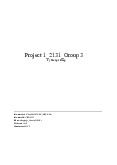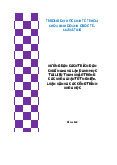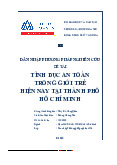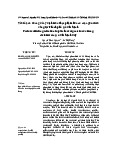





Preview text:
Indonesian Journal of Learning Studies
ISSN : 2775-5231
Correlation between TikTok Use and Teenagers’ Self Esteem 1 2
Rini Savira, Muhammad Rifai, 3Wahyunengsih Wahyunengsih
rini.savira21@mhs.uinjkt.ac.id
1,2,3 Universitas Islam Negeri Syarif Hidayatul ah Jakarta, Indonesia Submitted : 28 April 2022 Revised : 29 April 2022 Accepted : 30 April 2022 Abstract :
The existence of the TikTok is currently very much in demand, especial y among teenagers,
TikTok is a popular short video application developed by Chinese technology company
Beijing Bytedance, global amount monthly active user count has reached 500 mil ion. The
purpose of this study was to determine the self-esteem of teenagers when using the
Tiktok application. The object of this study was teenagers, the number of participants
involved was 41 people and the research data was in the form of a questionnaire.
The methodology used in this study is a descriptive correlation, in this study 29
respondents in Rosenberg's theory felt that there was nothing good in him and 18
respondents felt that other people on social media, especial y on TikTok, were much
better and accomplished than him; and as many as 26 respondents feel anxious about
other people's assessment of him. As many as 20 respondents always feel
inferior/insecure when they see other people's appearances on Tiktok. This proves that
the Tiktok application also has an effect on self-esteem among teenagers, this is what
causes a polemic on adolescent psychology; the adolescent phase is a phase where
thoughts/emotions are stil unstable, are looking for their identity, and are easy. Therefore
it is necessary to evaluate in this case, because if not, this can interfere with the
psychological health of adolescents.
Keywords: Tiktok Application, Teenagers, Self Esteem Published by:
Perkumpulan Dosen Muslim Indonesia - Sulawesi Selatan
Copyright © 2022 The Author(s)
This article is licensed under CC BY 4.0 License 19 1
Indonesian Journal of Learning Studies
Correlation between TikTok Use and Teenagers’ Self Esteem
Social media is very influential in various circles at this time. Plus, due to the covid-19 pandemic, al
forms of information can already be found on social media. Here is a theory about social media
according to Michael Cross (2013), social media is a term that describes a variety of technologies
used to bind people into cooperation, exchange information, and interact through web-based
message content. Because the internet is always developing, the various technologies and features
available to users are always changing. This makes social media more hypernymous than a specific
reference to various uses or designs. The higher the level of use of social media, the higher the level
of depression in a person. Depression is caused by social differences and comparing yourself with
other social media users which can lead to a negative view of yourself and distrust of yourself. (Aziz, 2020)
From the overal results of the analysis, there are indications that the Self-Promotion, Social
Interaction, Documentation, and Creativity motifs are stil being considered by Tiktok users during
the Covid-19 pandemic because the results obtained from these four motifs are in the medium
category. However, due to the PSBB regulations from the government, it causes them to prioritize
the Diversion motive because during the PSBB period people carry out their daily activities at home
and activities outside the home are also limited. This makes people bored and final y choose to play
Tiktok. (Andrian, Luik, W.Tjahjo, 2021)
Tiktok is a short video sharing platform where users can watch and produce quick videos using
music, stickers and animations as effects. Of course, the use of the TikTok application has a negative
impact, especial y in the focus on self-esteem. Self-esteem according to Rosenberg's theory is a
person's attitude based on his perception of how he values and values himself as a whole.
Stanley Coopersmith also explains in his work The Antecedents of Self Esteem, self-esteem is an
assessment of an individual's worthiness which is manifested in an individual's attitude towards
himself (in Desmita, 2012). Self-esteem according to Stanley Coopersmith (1967) is an evaluation
made by a person towards himself and is usual y an interpretation that a person receives from his
environment in the form of appreciation, acceptance and treatment he receives. Assessments made
by individuals also determine how individuals perceive themselves positively or negatively.
The intensity of the use of the TikTok application for adolescents in Gambut District, Banjar Regency
can affect the social interaction of adolescents, because the time of using the TikTok application is
carried out every time they have free time, which is currently a lot of activities or school assignments
are done online, so many teenagers to releasing boredom, they look for entertainment, namely by
playing TikTok where they can express themselves by creating video content they like, which causes
them to forget the time and the tasks they have to do, because they are too busy. cool with playing
TikTok, with behavior like that wil cause teenagers to be more lazy to learn because they are more
fun playing TikTok with their friends who both like the TikTok application and keep them away from
people who are not users of TikTok on the internet. because there are many people who look at
teenagers who often dance in a sex style for women it wil usual y be talked about by people around
him, which can lead to bullying. (Fauzun, Sanusi, Wafa, 2021)
The results showed that the intensity of using TikTok social media had no effect on a person's self-
confidence, because self-confidence was more in the context of academic ability, the influence of a
group and one's self-identity. Confidence is not an important factor for someone to be active in IJLS Vol. 2 No. 1, J anuari – April 2022 20
Indonesian Journal of Learning Studies
social media such as TikTok, more so to be confident in socializing in society. (Dewi, Putri, Nugraha, Haqi, 2020)
Most of the use of social media is among early teens, at that time an early teenager was stil looking
for his identity. High use of social media can affect the development of early adolescents in finding
their identity, because of the lack of direct interaction with their peers and causing a teenager to be
insecure, in this case it shows that there is no relationship between self-confidence and the intensity
of social media use. (Ardari, 2016)
Self-esteem is one of the factors that influence each student's self which has implications for the
learning process at school. By having high self esteem, it can prevent students from doing negative
things in achieving learning achievement. In the future, further research is needed to see the
relationship and influence of self-esteem on learning achievement, as wel as efforts that can be
made to increase students' self esteem. (Refnadi, 2018)
The increasing number of TikTok social media users among teenagers in Indonesia wil certainly
affect one of the stages of adolescent development, namely self-confidence. Having self-confidence
is very important because a teenager wil be able to assess himself and do a job effectively in his life. (Adawiyah, 2020)
There are many studies about the influence of TikTok to the psychological impact. First low self-
esteem, second syndrome, third lack of association with the surrounding environment, fourth sleep
conditions become less good. The difference between this study and previous research is that the
authors focus on adolescent self-esteem in late adulthood or early adulthood.
In this study the authors use the theory of Rosenberg (1965) which explains that self-esteem has the
meaning of the word self-esteem is a positive or negative attitude towards a particular object, where
the object is himself. According to Carver, Scheier & Segerstrom (2010) an individual must be able
to create an optimistic nature; If a person thinks optimistical y, he expects good things to happen.
Vice versa, if individuals are pessimistic, they wil expect bad things to happen
There is a significant correlation between self-confidence and self-image, meaning that the higher
the level of self-confidence, the higher the self-image in late adolescence, on the contrary, the lower
the level of self-confidence, the lower the level of self-image in late adolescence. Teenagers can be
expected to improve their self-image in a positive way by trying to stay confident with what is
happening and not give up. Next, teenagers must try to find out about how they look and accept
their physical condition. (Ramadhani, Putriani, 2014).
Can be used as material for reflection and self-reflection, in order to reduce narcissism and
adjustment to self-esteem through counseling services both classical y, in groups, and individual y,
so that it is expected to be able to manage the use of appropriate social media tiktok independently
and take advantage of good social conditions. (Putri, 2021)
The research methodology was carried out using descriptive correlation methods, with an aggregate
sample of 41 respondents. Correlational descriptive method is a research method that connects one
element/element with other elements/elements (Sugiyono, 2018). Descriptive method is a method
used to describe or analyze a study but is not used to attract broader conclusions (Sugiyono, 2011,
21). Descriptive method is a method for assessing the state of a group of people, objects, series of
conditions, thought systems, or classes of current events (moh. Nazir, 2012, 54).
The way a researcher solves a problem is by conducting research through the questions provided.
Specifical y, in a study that used Google Forms to retrieve data and information to identify the IJLS Vol. 2 No. 1, J anuary - April 2022 21
Indonesian Journal of Learning Studies
correlationof TikTok applications with adolescent self-esteem in the final stages, the tool was
questions for teens. In analyzing the data, the researchers found that 68.3% of teens want to look
like content creators. Researchers have found that teens at this level end up comparing themselves
to others on TikTok and feeling inferior/insecure when viewing or viewing other people's
appearances on TikTok. It disrupts your sleep patterns, and pessimism makes you feel anxious about
different judgments from others that you wil experience and face your own desires. The contents
of the questionnaire then became the basis for the results and discussion.
The results of the research that the researchers found were that of the 41 respondents who
answered the questionnaire, as many as 92.7% of teenagers used the TikTok application. As many
as 41.5% of teenagers tend to compare themselves after seeing TikTok content, as many as 14.6%
of teens experience excessive anxiety after viewing content on Tiktok, as many as 48.8% of teens
tend to always feel inferior/insecure when they see other people's achievements or performances
on Tiktok and Researchers found that 75.6% of teens access TikTok at night. Researchers found that
there are things that are quite significant. This proves that TikTok is not a major factor in low self-
esteem in teenagers. This evidence is strengthened by Rosenberg's theory, researchers use this
theory and the results of this theory as much as 70.7% feel there is nothing good in him, as many as
51.2% of adolescents are afraid to face new activities and as many as 63.4% of adolescents feel
anxious with the judgments of others. This proves that TikTok is not a major factor in low self-esteem in teenagers.
In this study, researchers found that almost al teenagers use TikTok social media. Teenagers use
TikTok social media to entertain themselves and relieve boredom and teenagers use the TikTok
application to channel their talents such as dancing, video editing and others because Tiktok can be
a medium to hone skil s and TikTok applications can make money if they have a lot of fol owers and views on uploaded videos.
The Negative Impact of the TikTok App on Teenagers
From the results of research, journals and articles related to TikTok have a negative impact on teenagers, including: 1. TikTok Syndrome 2. Sexual harassment 3. Lazy to study
4. Not getting along with the surrounding environment 5. Low self-esteem
In this study, researchers focused on the low self-esteem of teenagers due to using the TikTok
application. Self-esteem is a condition where one's thoughts, feelings, and views on oneself.
According to the results of the data obtained, some teenagers who use the TikTok application
experience low self-esteem due to seeing TikTok content that shows a person's strengths, ranging
from achievements, lifestyle, style of dress and also when they see someone who has a perfect
physique or commonly cal ed body goals. Therefore, the higher the level of use of social media, the
higher the level of depression in a person. The depression is caused by social differences and
comparing oneself to other social media users can lead to a negative view of oneself and self- esteem. IJLS Vol. 2 No. 1, J anuari – April 2022 22
Indonesian Journal of Learning Studies
Excessive anxiety, insecure/insecure can also appear when viewing videos on TikTok, this anxiety
includes limited abilities. When a teenager sees content on TikTok that shows the skil s and abilities
of someone who is an expert in a field, be it academic or non-academic. TikTok causes low self-
esteem, inferiority/insecure, anxiety about their abilities.
So it is clear, that TikTok social media is not the main factor of low self-esteem in adolescents but
only as an external influence. In accordance with Rosenberg's theory that the main factor of low
self-esteem is caused by internal influences, namely fear to start and afraid to try new things, they
assume that there is no ability in themselves and there is nothing good in them. Whereas low self-
esteem arises because they do not dare to start and do not want to try something new, what they
have in mind is only failure and judgment from others.
In this study, the researcher used a questionnaire method. Questionnaire method is data col ection
directly to respondents through fil ing out surveys. The purpose of the researcher using the
questionnaire is to obtain a number of data or information relevant to the research topic. This
questionnaire is divided into 2 parts, the first is a question about TikTok and the second is a
statement about self-esteem. Researchers use Rosenberg's theory to measure self-esteem in a person.
In this study, researchers examined whether there was a significant correlation between TikTok
users and low self-esteem in adolescents. In previous studies, it is true that TikTok is one of the
causes of low self-esteem in a person. Researchers found that the main factor in low self-esteem is
not because of TikTok, but because of internal factors. This statement is supported by Rosenberg's
theory which states that the main factor of low self-esteem is caused by internal influences. The
results obtained in this study are strongly supported by previous findings which state that TikTok
and other social media can cause low self-esteem.
Based on the results of the research that has been done, it can be concluded that there is no
relationship between weak self-esteem and the use of social media tiktok. This indicates that the
use of social media tiktok is only an external factor, not the main factor causing weak self-esteem in
adolescents, but due to the lack of a person's wil ingness to try new things and be afraid of failure.
1. Further research, it is recommended to conduct research directly on someone who has low
self-esteem, with the aim of finding out what are the main factors for weak self-esteem
2. Further research, it is recommended to explain what are the factors that influence weak self-esteem
Adawiyah Dwi (2020). Pengaruh Penggunaan Aplikasi TikTok Terhadap Kepercayaan Diri Remaja
di Kabupaten Sampang. (Accessed April 22, 2022)
Andrian, Luik, W.Tjahjo (2021). Motif Masyarakat Indonesia Menggunakan Aplikasi Tiktok
Selama Masa Pandemi Covid19 (Accessed April 22, 2022)
Ardari, C. (2016). Pengaruh Kepercayaan diri terhadap Intensitas Penggunaan Media Sosial pada
remaja Awal (PROGRAM STUDI PSIKOLOGI FAKULTAS PSIKOLOGI UNIVERSITAS SANATA
DHARMA YOGYAKARTA; Vol. 9). Retrieved from
https://repository.usd.ac.id/6571/2/119114160full.pdf
Aziz, A. A. Al. (2020). Hubungan antara intensitas penggunaan media sosial dan tingkat depresi
pada mahasiswa. Acta Psychologia, 2(2), 92–107. (Accessed April 20, 2022) IJLS Vol. 2 No. 1, J anuary - April 2022 23
Indonesian Journal of Learning Studies
Carver, Scheier & Segerstrom (2010). Optimism. Clinical Psychology Review (Accessed April 22, 2022)
Desmita (2012). Psikologi Perkembangan Peserta Didik. Bandung: PT. Remaja Rosdakarya offset. (Accessed April 22, 2022)
Dewi, Putri, Nugraha, Haqi (2020). Kepercayaa Diri degan Intensitas Penggunaa nMedia Sosial
TikTok di Masa Pandemi: Studi Korelasi. (Accessed April 22, 2022)
Fauzun, Sanusi, Wafa (2021). DAMPAK APLIKASI TIKTOK PADA INTERAKSI SOSIAL REMAJA
“STUDI DI KECAMATAN GAMBUT KABUPATEN
BANJAR”. (Accessed April 22, 2022)
Michael Cross (2013). Social Media Security; Leveraging Social Networking While Mitigating Risk (Accessed April 22, 2022)
Nazir (2012). Metode Penelitian (Accessed April 22, 2022)
Putri (2021). Perilaku Narsisme dan Harga Diri Terhadap Penggunaan Media Sosial TikTok
Pada Siswa SMA. (Accessed April 22, 2022)
Ramadhani, Putriani (2014). Hubungan Antara Kepercayaan Diri Dengan Citra Diri Pada
Remaja Akhir. (Accessed April 22, 2022)
Refnadi (2018). Konsep Self-Esteem Serta Implikasinya Pada Siswa (Accessed April 20, 2022)
Rosenberg (1965). Society and the Adolescent Self-Image (Accessed April 22, 2022)
Savira Rini (2021). Journal AL-HIKMAH Dakwah dan Ilmu Komunikasi; A SURVEY ON PROBLEMS
CAUSED BY PSYCHOLOGICAL FACTORS AMONG GEN Z (Accessed April 20, 2022)
Sihotang, Dampak Negatif TikTok Di Masa Pandemic, Universitas Lambung Mangkurat. (Accessed April 25, 2022)
Stanley Coopersmith (1967). Antecedents of Sel Esteem (Accessed April 22, 2022)
Sugiyono (2017). Metode Penelitian Kuantitatif, Kualitatif, dan R&D (Accessed April 22, 2022)
Wahyunengsih, W. (2018). Teachers’ Perspective on the Chal enges of Teaching English for Specific
Purposes in Indonesia. Journal of English for Academic
and Specific Purposes, 1(1), 22.
https://doi.org/10.18860/jeasp.v1i1.5243 IJLS Vol. 2 No. 1, J anuari – April 2022 24



